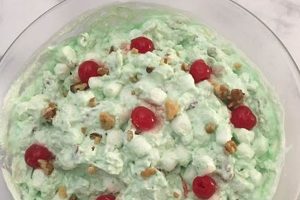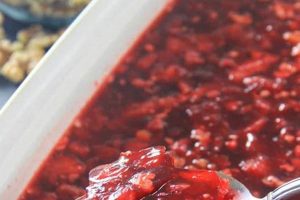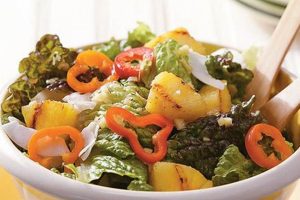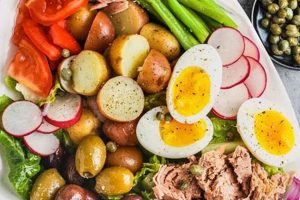A chilled dish featuring tender, cooked squid (calamari) combined with other seafood like shrimp, mussels, or octopus, often complemented by fresh vegetables such as celery, bell peppers, and onions. A vinaigrette dressing typically binds the ingredients, creating a light and refreshing meal. Variations exist, incorporating ingredients like olives, capers, herbs, and different types of dressings.
This type of salad offers a flavorful and nutritious option, rich in protein and omega-3 fatty acids. As a cold dish, it is particularly well-suited to warm weather and can be served as a light lunch, appetizer, or part of a larger buffet. Historically, similar seafood salads have appeared in various culinary traditions, often in coastal regions where fresh seafood is readily available. The modern iteration provides a convenient and appealing way to incorporate diverse seafood into one’s diet.
The following sections will explore various aspects of creating this dish, including selecting and preparing the calamari, choosing complementary seafood and vegetables, crafting the perfect vinaigrette, and presenting the salad for optimal visual appeal and flavor.
Tips for Calamari Seafood Salad Preparation
Achieving optimal flavor and texture requires careful attention to detail throughout the preparation process. The following tips offer guidance for creating a successful dish.
Tip 1: Calamari Selection and Preparation: Opt for fresh, high-quality calamari. Proper cleaning and tenderizing are crucial. Score the calamari bodies lightly before cooking to enhance tenderness and prevent curling.
Tip 2: Precise Cooking: Overcooked calamari becomes rubbery. Briefly blanch or saut until opaque and tender, avoiding prolonged cooking times.
Tip 3: Complementary Seafood Choices: Consider incorporating other seafood like cooked shrimp, mussels, or flaked fish. Ensure all seafood is cooked thoroughly before adding it to the salad.
Tip 4: Vegetable Selection and Preparation: Crisp vegetables like celery, bell peppers, and red onion provide textural contrast. Dice vegetables uniformly for even distribution and aesthetic appeal.
Tip 5: Dressing Selection: A light vinaigrette complements the delicate seafood flavors. Lemon juice, olive oil, and herbs create a classic combination. Experiment with different herbs and spices to enhance the flavor profile.
Tip 6: Chilling and Serving: Chill the salad thoroughly before serving to allow the flavors to meld. Garnish with fresh herbs or a sprinkle of paprika for added visual appeal.
Tip 7: Mindful Ingredient Proportions: Balance the proportions of calamari, other seafood, and vegetables to create a harmonious blend of flavors and textures.
By following these guidelines, one can create a seafood salad that is both flavorful and visually appealing. Attention to detail in each step contributes to the overall success of the dish.
The following section will provide a complete recipe incorporating these tips, guiding the reader through the process of creating a delightful calamari seafood salad.
1. Fresh, High-Quality Calamari
The foundation of a successful calamari seafood salad rests upon the selection of fresh, high-quality calamari. Its influence extends beyond mere texture, affecting the overall flavor profile and dining experience. Understanding the characteristics of superior calamari is essential for achieving optimal results.
- Appearance and Aroma:
Fresh calamari exhibits a glistening, translucent white appearance with a firm texture. The aroma should be mild and oceanic, devoid of any fishy or ammonia-like odors, which indicate spoilage. A pearly sheen and clean fragrance signify proper handling and storage.
- Texture and Handling:
The flesh should be firm and elastic, springing back to the touch. Avoid specimens that appear limp, slimy, or discolored. Proper handling during processing and transport is critical for maintaining quality, minimizing damage to the delicate flesh.
- Sourcing and Storage:
Whenever possible, source calamari from reputable fishmongers or suppliers who prioritize sustainable fishing practices. Proper storage is equally important. Fresh calamari should be kept chilled on ice and used within one to two days of purchase to ensure optimal freshness.
- Impact on Culinary Outcome:
The quality of calamari directly impacts the final dish. Fresh calamari cooks evenly, resulting in a tender, flavorful product. Conversely, lower-quality calamari may become tough or develop an unpleasant flavor during cooking, detracting from the overall enjoyment of the salad.
By prioritizing the selection of fresh, high-quality calamari, one ensures a superior culinary experience. The subtle nuances of appearance, aroma, texture, and sourcing contribute significantly to the success of the calamari seafood salad, elevating it from a simple dish to a culinary delight.
2. Precise Cooking Techniques
Precise cooking techniques are paramount in a calamari seafood salad recipe. Calamari, with its delicate texture, requires careful handling to avoid undesirable outcomes. Overcooking results in a rubbery, chewy consistency, significantly detracting from the salad’s appeal. Conversely, undercooking poses food safety risks. The goal is to achieve a tender, opaque, and safe-to-consume product. This balance is achieved through specific methods and attentive timing.
Several techniques achieve optimal calamari texture. Brief blanching in boiling water for 30-60 seconds, followed by an ice bath, quickly cooks the calamari while preserving tenderness. Sauting over high heat for 1-2 minutes offers another approach, allowing for flavorful browning while maintaining a desirable texture. Grilling, while less common, can impart a smoky char when executed quickly. Regardless of the method, close monitoring and precise timing are critical. A visual cue the calamari turning opaque signals doneness. Adhering to these practices ensures a pleasant textural experience.
The impact of precise cooking extends beyond texture. Properly cooked calamari absorbs flavors from the dressing and other salad components more effectively. Overcooked calamari, having a dense structure, hinders flavor penetration. This illustrates the interconnectedness of cooking technique and flavor development within the broader recipe context. Mastering these techniques contributes significantly to the overall success of the calamari seafood salad, highlighting the crucial role of precision in culinary endeavors.
3. Complementary Seafood Choices
Complementary seafood choices play a crucial role in elevating a calamari seafood salad recipe beyond a single-note dish. Careful selection of additional seafood broadens the flavor profile, introduces textural variety, and enhances the nutritional value. The interplay between calamari and its accompanying seafood components contributes significantly to the overall dining experience. Considerations of flavor compatibility, textural contrast, and potential synergistic effects guide these choices.
Shrimp, with its sweet and succulent character, offers a natural complement to calamari’s delicate flavor. Mussels, possessing a richer, brinier taste, introduce a contrasting element that enhances complexity. Flaked white fish, such as cod or haddock, provides a neutral canvas that absorbs the flavors of the dressing and other ingredients, while adding a flaky texture. Octopus, while similar in texture to calamari, imparts a distinct, slightly chewier texture and a subtly different flavor. The selection process hinges on the desired balance of flavors and textures, aligning with the overall culinary vision for the salad.
Understanding the characteristics of each seafood type allows for strategic combinations. For a lighter, more delicate salad, shrimp and flaked white fish harmonize well with calamari. A bolder, more robust salad might benefit from the inclusion of mussels or octopus. The proportions of each seafood component also influence the final outcome. Calamari typically serves as the centerpiece, with other seafood playing supporting roles. Careful consideration of these factors ensures a well-balanced and harmonious calamari seafood salad, maximizing both flavor and textural complexity.
4. Crisp vegetable selection
Crisp vegetable selection is integral to a successful calamari seafood salad recipe, providing crucial textural contrast and balancing the richness of the seafood. The chosen vegetables contribute not only to the salad’s sensory appeal but also enhance its nutritional value and visual presentation. Strategic selection elevates the dish from simple to sophisticated.
- Textural Contrast and Flavor Balance
Crisp vegetables, such as celery, bell peppers, fennel, and jicama, provide a refreshing counterpoint to the tender calamari and other seafood. Their contrasting textures create a more dynamic and enjoyable eating experience. The subtle flavors of these vegetables also balance the richness of the seafood and dressing, preventing the salad from becoming overly heavy or one-dimensional. Celery adds a slightly bitter note, bell peppers offer sweetness, fennel introduces a hint of anise, and jicama provides a mild, nutty flavor.
- Nutritional Enhancement and Visual Appeal
Incorporating a variety of colorful vegetables increases the salad’s nutritional content. Bell peppers, for instance, are rich in Vitamin C, while fennel provides dietary fiber. The vibrant colors of these vegetables also enhance the salad’s visual appeal, making it more appetizing. The interplay of colors and textures creates a visually stimulating dish, encouraging consumption.
- Preparation Methods and Flavor Integration
The way vegetables are prepared influences their contribution to the salad. Thinly slicing or dicing vegetables ensures even distribution and allows them to absorb the flavors of the dressing. Blanching certain vegetables, such as green beans or asparagus, can enhance their color and tenderness while retaining their crispness. These choices further refine the salad’s textural and flavor profile.
- Balancing Proportions and Flavor Combinations
The proportion of vegetables to seafood is a key consideration. Overloading the salad with vegetables can overshadow the delicate seafood flavors, while too few vegetables diminish the desired textural contrast. Flavor compatibility also plays a role. For example, the anise notes of fennel pair well with bolder seafood like mussels, while the sweetness of bell peppers complements the milder flavor of shrimp. Careful balancing ensures a harmonious blend of flavors and textures.
The considered selection and preparation of crisp vegetables elevates the calamari seafood salad from a simple combination of ingredients to a multi-faceted culinary experience. The interplay of textures, flavors, and colors enriches the overall sensory perception, demonstrating the significant contribution of vegetables to this dish.
5. Flavorful Vinaigrette
A flavorful vinaigrette is essential to a successful calamari seafood salad recipe, acting as a unifying element that binds the diverse ingredients and elevates the overall flavor profile. The vinaigrette’s acidity complements the seafood’s natural sweetness, while its other components contribute complexity and depth. Careful consideration of the vinaigrette’s composition is crucial, as it significantly impacts the final dish’s balance and harmony.
- Acidity and Brightness
The vinaigrette’s acidity, derived from ingredients like lemon juice, vinegar, or lime juice, provides brightness and cuts through the richness of the seafood. This acidic element balances the salad’s overall flavor profile, preventing it from becoming overly heavy or cloying. The specific type of acid used influences the final taste; lemon juice imparts a citrusy freshness, while red wine vinegar adds a subtle tartness. The level of acidity should be carefully calibrated to complement, not overpower, the delicate flavors of the calamari and other seafood.
- Oil and Texture
The oil component of the vinaigrette contributes to the salad’s texture and mouthfeel. Extra virgin olive oil, with its fruity notes and smooth texture, is a classic choice. Other oils, such as avocado oil or grapeseed oil, can also be used, each imparting its unique flavor and texture. The ratio of oil to acid affects the vinaigrette’s consistency and how it coats the salad ingredients. A higher proportion of oil creates a richer, more emulsified dressing, while a higher proportion of acid results in a lighter, more tart vinaigrette.
- Aromatic Enhancements
Aromatic enhancements, such as herbs, spices, and aromatics, add depth and complexity to the vinaigrette. Fresh herbs like parsley, dill, and chives provide bright, herbaceous notes. Minced garlic or shallots offer pungent accents, while spices like red pepper flakes introduce a touch of heat. The selection of aromatics should complement the other salad ingredients and create a cohesive flavor profile. For example, a lemon-herb vinaigrette pairs well with shrimp and fennel, while a Dijon-based vinaigrette complements mussels and celery.
- Emulsification and Stability
Proper emulsification ensures the vinaigrette’s ingredients combine evenly and do not separate. Whisking the oil and acid together vigorously creates a stable emulsion that coats the salad ingredients evenly. Adding a small amount of emulsifying agent, such as Dijon mustard or honey, further stabilizes the vinaigrette and enhances its texture. A stable emulsion prevents the salad from becoming watery and ensures that each bite delivers a balanced combination of flavors.
The carefully crafted vinaigrette elevates the calamari seafood salad, transforming it from a simple assemblage of ingredients into a cohesive and flavorful dish. The vinaigrette’s acidity, oil, aromatics, and emulsification all contribute to the final product’s sensory experience, demonstrating the significant impact of this seemingly simple component. The balance and harmony achieved through a well-made vinaigrette underscore its crucial role in the overall success of the calamari seafood salad recipe.
6. Proper Chilling Duration
Proper chilling duration is a crucial element in calamari seafood salad preparation, significantly influencing the final dish’s flavor and texture. Chilling allows the flavors of the various componentsthe calamari, other seafood, vegetables, and vinaigretteto meld and harmonize. This process enhances the overall sensory experience, transforming individual ingredients into a cohesive and flavorful salad.
- Flavor Development
Chilling allows the vinaigrette to permeate the calamari and other seafood, enhancing their flavor and creating a more homogenous taste experience. The low temperature slows down enzymatic activity, preserving the fresh flavors of the ingredients and preventing undesirable changes in taste or aroma. This gradual flavor infusion is essential for achieving a well-balanced and nuanced salad. For instance, the subtle anise notes of fennel or the brininess of mussels become more integrated with the calamari and dressing over time.
- Texture Enhancement
Chilling firms the calamari and other seafood, enhancing their textural appeal. The cold temperature also helps maintain the crispness of the vegetables, creating a desirable textural contrast within the salad. A well-chilled salad offers a more pleasing mouthfeel, with the tender seafood juxtaposed against the crisp vegetables. This textural interplay contributes significantly to the overall enjoyment of the dish.
- Food Safety Considerations
Proper chilling is essential for food safety, particularly with seafood. Maintaining a low temperature inhibits the growth of harmful bacteria, ensuring the salad remains safe for consumption. Adhering to recommended chilling times and temperatures minimizes the risk of foodborne illness. This aspect of food safety is paramount when preparing dishes containing perishable ingredients like seafood.
- Optimal Chilling Time
The optimal chilling duration for calamari seafood salad is typically between one and two hours. This timeframe allows sufficient time for flavor development and textural enhancement without compromising the quality of the ingredients. Over-chilling can lead to undesirable changes in texture, such as the vegetables becoming soggy. Finding the right balance between chilling time and desired outcome is essential for achieving the perfect calamari seafood salad.
Proper chilling duration, therefore, is not merely a final step but an integral part of the calamari seafood salad recipe. It is a crucial factor that influences flavor development, texture enhancement, and food safety. Understanding the nuances of chilling and its impact on the various components of the salad allows for precise control over the final product, ensuring a delicious and safe culinary experience.
7. Balanced Ingredient Proportions
Balanced ingredient proportions are fundamental to a successful calamari seafood salad recipe. Harmony among the componentscalamari, additional seafood, vegetables, and vinaigretteis crucial. An overabundance of any single ingredient can overshadow the others, diminishing the complexity and overall enjoyment of the salad. Careful consideration of proportions ensures that each element contributes appropriately to the final product, creating a well-rounded and satisfying culinary experience.
Consider the interplay between calamari and other seafood. While calamari typically serves as the primary component, the addition of shrimp, mussels, or flaked fish enhances both flavor and textural diversity. However, excessive amounts of secondary seafood can overpower the delicate flavor of the calamari. Similarly, an overabundance of vegetables, while contributing nutritional value and textural contrast, can dilute the seafood’s presence. The vinaigrette, while essential for binding the ingredients and adding brightness, should complement rather than dominate the other flavors. A balanced approach allows each element to shine without overshadowing the others. For example, a salad with a 1:1 ratio of calamari to other seafood, complemented by a proportionate amount of vegetables and a judiciously applied vinaigrette, exemplifies balanced proportions. Conversely, a salad dominated by vegetables or overwhelmed by a pungent vinaigrette would lack balance.
Achieving balanced ingredient proportions requires careful planning and execution. Recipes provide a starting point, but individual adjustments may be necessary based on personal preferences and ingredient availability. A thoughtful approach to proportioning ensures that the calamari seafood salad delivers a harmonious blend of flavors, textures, and visual appeal. This attention to detail elevates the dish from a simple combination of ingredients to a well-executed culinary creation.
Frequently Asked Questions
This section addresses common inquiries regarding calamari seafood salad preparation, offering concise and informative responses to facilitate a successful culinary outcome.
Question 1: How can rubbery calamari be avoided?
Rubbery calamari results from overcooking. Employing rapid cooking methods, such as blanching for 30-60 seconds or sauting for 1-2 minutes, prevents this undesirable texture. Monitoring the calamari closely and removing it from heat as soon as it turns opaque ensures tenderness.
Question 2: What are suitable alternatives to lemon juice in the vinaigrette?
Lime juice or white wine vinegar offer viable alternatives to lemon juice, imparting distinct yet complementary acidic notes to the vinaigrette. The choice depends on desired flavor profiles and compatibility with other ingredients.
Question 3: Can frozen calamari be used for this recipe?
While fresh calamari is preferred, frozen calamari can be substituted if thawed completely and patted dry before cooking. Adjust cooking times slightly, as frozen calamari may require a few additional seconds to cook thoroughly.
Question 4: How long can calamari seafood salad be stored safely?
Refrigerated storage in an airtight container allows for safe consumption for up to two days. Beyond this timeframe, the quality and safety of the salad may be compromised.
Question 5: What are some suitable substitutes for celery or bell peppers?
Fennel, jicama, or diced cucumber offer viable alternatives to celery and bell peppers, providing distinct textures and flavors that complement the seafood components.
Question 6: How can the salad be adapted for those with shellfish allergies?
Substituting calamari and other shellfish with firm, white fish, such as cod or halibut, creates a shellfish-free version while maintaining a similar textural profile. Ensure appropriate adjustments to cooking times for the chosen fish.
Understanding these common concerns helps ensure a successful and enjoyable calamari seafood salad preparation experience. Attention to detail in each step contributes to the final dish’s overall quality and flavor.
The next section provides a comprehensive list of ingredients and step-by-step instructions for creating the perfect calamari seafood salad.
Calamari Seafood Salad Recipe
This exploration of calamari seafood salad recipes has highlighted the multifaceted nature of this dish. From the selection of fresh, high-quality calamari to the precise cooking techniques employed, each step contributes significantly to the final outcome. The careful consideration of complementary seafood and crisp vegetables, combined with the artful creation of a flavorful vinaigrette, elevates this dish beyond a simple salad. Proper chilling duration and balanced ingredient proportions further refine the culinary experience, ensuring a harmonious blend of flavors, textures, and aromas. The frequently asked questions section addresses common concerns, providing practical guidance for achieving optimal results.
Culinary success with this dish hinges on a thorough understanding of these elements. Attention to detail and a commitment to quality ingredients unlock the full potential of the calamari seafood salad recipe, transforming it into a culinary masterpiece. Exploration of variations and personal adaptations further enrich the culinary journey, offering endless possibilities for creative expression.






